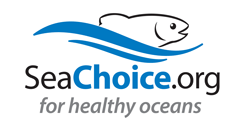 SeaChoice is a collaboration of five internationally recognized organizations that brought their broad, national expertise to form SeaChoice as part of the 'Sustainable Seafood Canada' coalition to help Canadians take an active role in supporting sustainable seafood and aquaculture. The coalition aims to raise public awareness of the threats to the oceans and the solutions that sustainable fisheries offer. Member organizations have a demonstrated history of engagement in markets-based campaigning and policy reform for fisheries.
SeaChoice is a collaboration of five internationally recognized organizations that brought their broad, national expertise to form SeaChoice as part of the 'Sustainable Seafood Canada' coalition to help Canadians take an active role in supporting sustainable seafood and aquaculture. The coalition aims to raise public awareness of the threats to the oceans and the solutions that sustainable fisheries offer. Member organizations have a demonstrated history of engagement in markets-based campaigning and policy reform for fisheries.
SeaChoice works in collaboration with the Monterey Bay Aquarium's Seafood Watch Program. SeaChoice uses Seafood Watch ratings as well has a science staff that writes reports using Seafood Watch methodologies for several Canadian fisheries.
Seafood RecommendationsFinal Score for Wild Fisheries = geometric mean of the four scores (Criterion 1-4).
Final Score for Aquaculture = geometric mean of the eight scores (Criterion 1-8).
| Symbol | Seafood Rating | Seafood Rating Summary |
Seafood Watch Scoring |
|
best choice* |
|
Wild Fisheries: Final score > 3.2 and no individual criterion scores of "Red" or "Critical" | |
| Aquaculture: Final score between 6.666 and 10, and no Red criteria, and no Critical scores |
| |
Some concerns*
|
|
Wild Fisheries: Final score > 2.2 and neither Management factor scores (3.1 & 3.2) are Red (<= 2.2) and no more than one criterion score of Red and no Critical scores, and doesn't meet criteria for "Best Choice." |
| Aquaculture: Final score between 3.333 and 6.666, and/or one Red criterion, and no Critical scores |
|
AVOID
|
|
Wild Fisheries: Final Score <=2.2, or one/both Management factor scores (3.1 & 3.2) are Red (<= 2.2), or two or more criteria score Red, or one or more Critical criteria scores. | |
| Aquaculture: Final score between 0 and 3.333, or more than one Red criterion, or one or more Critical scores |
^ Because effective management is an essential component of sustainable fisheries, Seafood Watch issues an Avoid recommendation for any fishery scoring Red for Management (Criterion 3).
*Products posted on FishChoice primarily under the SeaChoice ratings must be either a "Best Choice" or "Some Concerns."
Sustainable Seafood Criteria Wild Fisheries Criteria 1. Impacts of Fishery on the Stock in Question
1.1 Inherent resilience of the stock
1.2 Health of the stock
1.3 Fishing pressure
2. Impacts on Other Species
2.1 Inherent Resilience of the bycatch and other retained stocks
2.2 Health of the bycatch and other retained stocks
2.3 Mortality caused by this fishery on bycatch and other retained stocks
2.4 Secondary factor: discards and bait use
3. Effectiveness of Management
3.1 Management of fishery's impacts on fished stocks
3.2 Management of fishery's impacts on bycatch species
4. Habitat & Ecosystem Effects
4.1 Impact of fishing gear on the substrate
4.2 Modifying factor: mitigation of fishing gear impacts
4.3 Ecosystem and food web considerations
1. Data
1.1 Data relevance
1.2 Data quality
2. Effluent
2.1 Waste discharged per ton of fish
2.2 Management of farm-level and cumulative impacts
3. Habitat
3.1 Habitat conversion and function
3.2 Farm siting management effectiveness
3.3X Predator and wildlife mortalities
4. Chemical Use
4.1 Evidence or risk of chemicals use
5. Feed
5.1 Wild fish use
5.2 Net protein gain or loss
5.3 Feed footprint
6. Escapes and Introduced Species
6.1 Escape of principal farmed species
6.2X Escape of unintentionally introduced species
7. Disease, Pathogen and Parasite Interaction
7.1 Disease, pathogen and parasite interaction
8. Source of Stock - Independence from Wild Fish Stocks
8.1 Independence from Wild Fish Stocks
